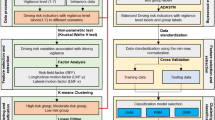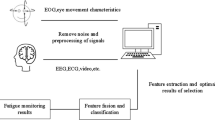Abstract
Real risk status detection is an effective way to reflect risky or dangerous driving behaviors and therefore to prevent road traffic accidents. However, a driver’s risk status is not only difficult to define but also uncontrollable and uncertain. In this study, a simulated experiment with 30 drivers was conducted using a driving simulator to collect the multi-sensor data of road conditions, humans, and vehicles. The driving risk status was classified into three states (0 - incident, 1 - near crash, or 2 - crash) on the basis of the playback system of the driving simulator. The experimental data were pre-processed using the cubic spline interpolation method and the time-windows theory. A driving risk status identification model was established using the C5.0 decision tree algorithm, and the receiver operating characteristic curve (ROC) was adopted to evaluate the performance of the identification model. The results indicated that respiration (RESP), vehicle speed (SPE), SM_FATIGUE, distance to the left lane (LLD), course angle (CA), and skin conductivity (SC) had a significant correlation (p < 0.05) with the driving risk status. The identification accuracy of the C5.0 decision tree algorithm was 78%, and the areas under the ROC were 0.934, 0.77, and 0.845, respectively. Moreover, compared with other four identification algorithms, the algorithm performance evaluation indexes TPR (0.780), precision (0.753), recall (0.78), F-measure (0.756), and kappa (0.884) of the C5.0 decision tree were all the best. The conclusion can provide reference evidence for danger warning systems and intelligent vehicle design.














Similar content being viewed by others
Data availability
The data used to support the findings of this study are available from the corresponding author upon request.
References
Zhou T, Zhang J (2019) Analysis of commercial truck drivers’ potentially dangerous driving behaviors based on 11-month digital tachograph data and multilevel modeling approach. Accid Anal Prev 132:105256–105256
Dingus TA, Klauer SG, and Neale VL, 2006. The 100-Car naturalistic driving study phase II – results of the 100-Car field experiment, Chart (2006) no, HS–810 593.
Graham R, Carter C (2001) Voice dialling can reduce the interference between concurrent tasks of driving and phoning. Int J Veh Des 26:30–47
Dula CS, Geller ES (2003) Risky, aggressive, or emotional driving: addressing the need for consistent communication in research. J Saf Res 34:559–566
Kamijo S, Matsushita Y, Ikeuchi K, Sakauchi M (2000) Traffic monitoring and accident detection at intersections. IEEE Trans Intell Transp Syst 1:108–118
Charlton SG (2009) Driving while conversing: cell phones that distract and passengers who react. Accid Anal Prev 41:160–173
Caird JK, Willness CR, Steel P, Scialfa C (2008) A meta-analysis of the effects of cell phones on driver performance. Accid Anal Prev 40:1282–1293
Guo Z (2009) Theories and methods on driving risk status identification. Southwest Jiaotong University (In Chinese), Chengdu
Sagberg F, Selpi, Piccinini GFB, Engstrom J (2015) A review of research on driving styles and road safety. Hum Factors 57:1248–1275
Chen S-W, Fang C-Y, Tien C-T (2013) Driving behaviour modelling system based on graph construction. Transport Res Part C-Emerg Technol 26:314–330
Z. Chen, Y. Zhang, C. Wu, and B. Ran, (2019) Understanding individualization driving states via latent Dirichlet allocation model, IEEE Intell Transport Syst Mag 1-1.
Simons-Morton BG, Klauer SG, Ouimet MC, Guo F, Albert PS, Lee SE, Ehsani JP, Pradhan AK, Dingus TA (2015) Naturalistic teenage driving study: findings and lessons learned. J Saf Res 54:41–44
Macadam CC (2003) Understanding and modeling the human driver. Veh Syst Dyn 40(1-3):101–134
Dehban A, Sajedin A, and Menhaj MB, (2016) A cognitive based driver’s steering behavior modeling, 2016 4th International Conference on Control, Instrumentation, and Automation (ICCIA).
Hills PJ, Catherine T, Michael PJ (2018) Detrimental effects of carryover of eye movement behaviour on hazard perception accuracy: effects of driver experience, difficulty of task, and hazardousness of road. Transport Res Part F Traffic Psychol Behav 58:906–916
Lantieri C, Lamperti R, Simone A, Costa M, Vignalia V, Sangiorgia C, Dondia G (2015) Gateway design assessment in the transition from high to low speed areas. Transport Res F: Traffic Psychol Behav 34:41–53
Li G, Wang Y, Zhu F, Sui X, Wang N, Qu X, Green P (2019) Drivers’ visual scanning behavior at signalized and unsignalized intersections: a naturalistic driving study in China. J Saf Res 71:219–229
Jimenez-Pinto J, Torres-Torriti M (2012) Face salient points and eyes tracking for robust drowsiness detection. Robotica 30:731–741
Zhang W Eye gaze estimation from the elliptical features of one iris. Opt Eng 50(2011):047003–047009
Abdelwahab H, Abdel-Aty M (2001) Development of artificial neural network models to predict driver injury severity in traffic accidents at signalized intersections. Transport Res Record J Transport Res Board 1746:6–13
Hernandezgress N, and Esteve D, (1995) Multisensory fusion and neural networks methodology: application to the active security in driving behavior, Steps Forw Intell Transport Syst World Congress.
Huang C, Wang X, Cao J, Wang S, and Zhang Y, (2020) HCF: a hybrid CNN framework for behavior detection of distracted drivers, IEEE Access PP, 1-1.
Jeberson W, Kishor A, Chakraborty C (2021) Intelligent healthcare data segregation using fog computing with internet of things and machine learning. Int J Eng SystModel Simul 1(1):1
Sant A, Garg L, Xuereb P, and Chakraborty C, (2021) A novel green IoT-based pay-as-you-go smart parking system. Computers, Materials and Continu.
Wang J, Zheng Y, Li X, Yu C, Kodaka K, Li K (2015) Driving risk assessment using near-crash database through data mining of tree-based model. Accid Anal Prev 84:54–64
Li W, Shimin L, Jingfeng Y, Nanfeng Z, Ji Y, Yong L, Handong Z, Feng Y, Zhifu L (2017) Dynamic traffic congestion simulation and dissipation control based on traffic flow theory model and neural network data calibration algorithm. Complexity 2017:1–11
AlKheder S, AlRukaibi F, and Aiash A (2020) Risk analysis of traffic accidents’ severities: an application of three data mining models, ISA transactions.
Cura A, Kucuk H, Ergen E, and Oksuzoglu IB, (2020) Driver profiling using Long Short Term Memory (LSTM) and Convolutional Neural Network (CNN) methods, IEEE Transactions on Intelligent Transportation Systems PP, 1-11.
Kumagai T, Akamatsu M (2006) Prediction of human driving behavior using dynamic Bayesian networks. LEICE Trans Inform Syst E89D:857–860
Chen Z, Cai H, Zhang Y, Wu C, and Sotelo MA, (2019) A novel sparse representation model for pedestrian abnormal trajectory understanding, Expert Syst Appl 138.
Yan L, Huang Z, Zhang Y, Zhang L, Zhu D, Ran B (2017) Driving risk status prediction using Bayesian networks and logistic regression. IET Intell Transp Syst 11:431–439
Panagopoulos G, Pavlidis I (2020) Forecasting markers of habitual driving behaviors associated with crash risk. IEEE Trans Intell Transp Syst 21:841–851
Quinlan R (2004). Data mining tools See5 and C5.0,
Breiman L, (1984) Classification and regression trees, Wadsworth International Group.
Berry M, Lino G (2004) Data mining techniques. Wiley, Indianapolis
Guo F, Fang Y (2013) Individual driver risk assessment using naturalistic driving data. Accid Anal Prev 61:3–9
Xu X-y, Liu J, Li H-y, Hu J-Q (2014) Analysis of subway station capacity with the use of queueing theory. Transport Res Part C-Emerg Technol 38:28–43
Funding
This study is sponsored by the National Natural Science Foundation of China under Grants 51805169, 52072288. This study is also supported by Natural Science Foundation of Jiangxi Province under Grant 20202BABL212009. This work is also sponsored by the National Natural Science Foundation of China under Grant 52072288. This study is also sponsored by the Special Fund for Graduate Student Innovation of Jiangxi Province (YC2020-S330).
Author information
Authors and Affiliations
Corresponding author
Ethics declarations
Conflict of interest
The authors declare no competing interests.
Additional information
Publisher’s note
Springer Nature remains neutral with regard to jurisdictional claims in published maps and institutional affiliations.
Rights and permissions
About this article
Cite this article
Yan, L., Gong, Y., Chen, Z. et al. Automatic identification method for driving risk status based on multi-sensor data. Pers Ubiquit Comput 27, 1303–1319 (2023). https://doi.org/10.1007/s00779-021-01580-x
Received:
Accepted:
Published:
Issue Date:
DOI: https://doi.org/10.1007/s00779-021-01580-x




